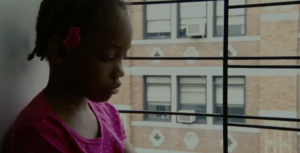
David Guggenheim’s documentary, Waiting for “Superman,” addresses a broken education system that seems impossible to fix. The film follows five children through their process of applying to Charter Schools. Faced against great odds, one was accepted, three were declined, and one was later accepted off the waitlist.
Towards the end of the film, one of the students, Bianca, is unable to attend her parochial school’s graduation ceremony. Her mother, Nakia, had recently lost hours at work and was unable to keep up with the $500 a month tuition. In this key scene, Nakia tears up explaining that she asked the principal, “Why penalize her for my responsibility?… To not let her be a part of the ceremony is just harsh” (Guggenheim 1:11:00). The filmmakers shot this scene so that the camera pans over both mother and daughter’s disappointed faces as Bianca watches her peers enter their school – directly across the street for their graduation ceremony. This influential scene depicts the way that Bianca’s parochial school punishes her for something that was out of her control. She is clearly confused, and asks her mother, “I’m not graduating…When am I gonna graduate?” (Guggenheim 1:10:24). This scene captures how a Harlem school was unwilling to accommodate its student, and instead made her feel ostracized from her educational community.


Another student in the documentary, Daisy, wants to go to medical school, but is on track to feed into Roosevelt High School. It is described as one of the worst preforming schools in Los Angeles. The narrator says, “Only three out of one hundred students at Roosevelt will graduate with the classes necessary for admission to a four year university, and 57% of Daisy’s classmates won’t graduate” (Guggenheim 21:31). Dr. Robert Balfanz, a professor at Johns Hopkins University, uses the term “dropout factories” at 21:59 of Waiting For “Superman.” He uses this term to describe the more than 2,000 schools across the United States like Roosevelt that push students through the system until they are too far behind proficiency levels to do anything besides drop out. He calls these schools where over 40% of the students don’t graduate, dropout factories.
The filmmakers use Bianca and Daisy as examples of students that face great obstacles in succeeding. They are quick to label schools as “dropout factories,” and show the perceived advantages of a non-tracking, innovative Charter School classrooms. However, the film uses selection bias, and does not address the good that can come from tracking in public schools, or the success that can come from attending a traditional public school. The film is biased towards all of the negatives that poor city schools face and present Charter Schools as the solution to every problem. In reality they may not be just that. The film creates another hole for itself because it does not even address Magnet Schools.
Guggenheim, Davis. Waiting for “Superman.” 2010. Film.